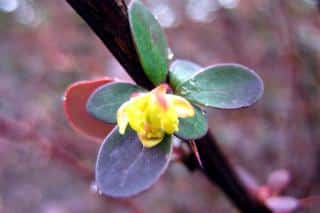

Berberis thunbergii is a beautiful berberis shrub, especially because of its blooming and its scarlet red berries that make birds tweet with joy in winter.
Basic Berberis thunbergii facts
Name – Berberis thunbergii
Family – Berberidaceae
Type – shrub
Height – 3 to 10 feet (1 to 3 m)
Exposure – full sun, part sun
Soil – ordinary, well drained
Foliage – deciduous or persistent depending on the variety
Flowering – April-May
It is preferable to plant Berberis thunbergii in fall to favor root development before winter hits, and thus ensure proper growth in spring.
It is possible to plant in spring specimens purchased in containers. In that case, water more diligently when the first heat waves hit, and/or if days on end go by without rain.
You can also grow many cultivars as indoor Berberis plants, in containers.
For Berberis thunbergii hedges, go for one pruning each in fall and spring to shape it into the silhouette you desire.
As a standalone, Berberis thunbergii can be pruned back in fall more or less by ¼ its height in order to boost blooming in spring.

It has been grown in Europe since the 19th century.
It now encompasses several hundred species and this provides for a variety of shapes and colors. Some grow taller than a person, but dwarf berberis cultivars stay small enough to grow wonderful low hedges.
It can be found with either green or purple leafage and the blooming ranges from pink to white through yellow and orange.
It produces nice bunches of yellow and red colored flowers that transform into red berries that make birds sing with joy since they stay all winter long.
This shrub’s hardiness deserves respect and you won’t need to add any fertilizer or other maintenance amendments.